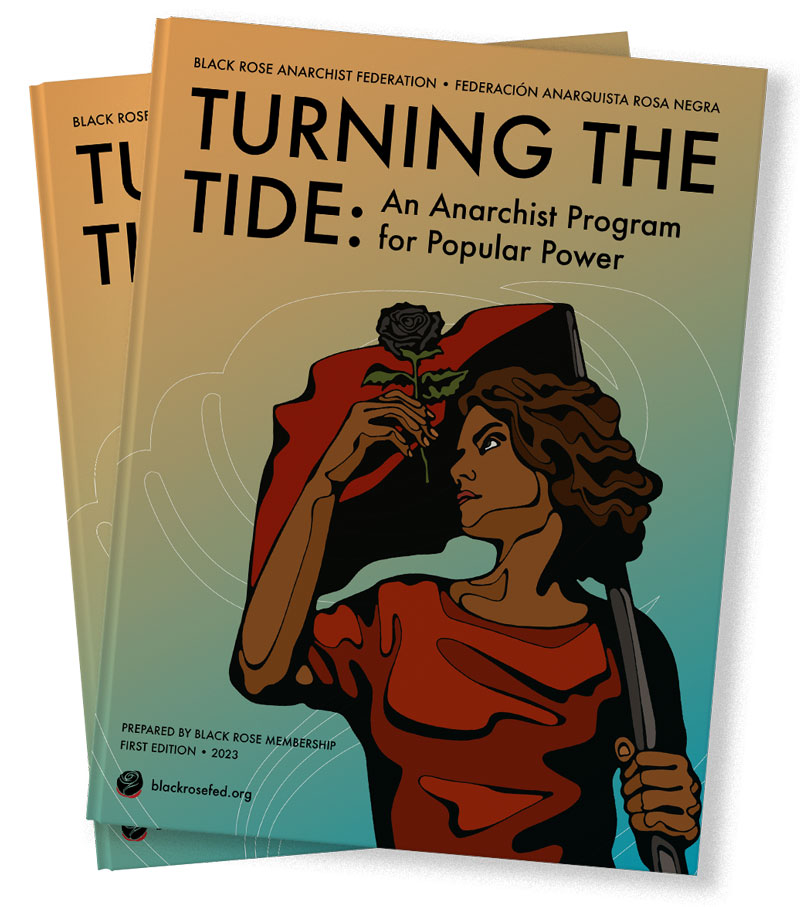
Illustration by Dinelli.
On the 1st of May 1886, hundreds of thousands of workers across the United States initiated a general strike to demand the working day be limited to 8 hours. During a mass meeting in Chicago’s Haymarket Square, a bomb was thrown. After the resultant chaos, 8 anarchist labor leaders were jailed on flimsy evidence supposedly implicating them as conspirators. A year later, 4 were hanged to death by the state.
To this day, May 1 is used as a marker to celebrate the wins of the dominated classes, to remember our martyrs, and to recommit ourselves to the ongoing struggle for self emancipation. May Day is our day, let’s use it to take stock of where we stand so that we can more effectively navigate toward the horizon of social revolution.
Where We Stand
In the last years we’ve seen small, but significant, steps toward a rejuvenation of the US labor movement. In 2022, major strikes increased by a factor of nearly 50% when compared to 2021, recovering a multi-year upward trend for labor action that had been dampened by the onset of the pandemic. Of these strikes, workers in the social reproductive sectors of the economy—healthcare and education—made up the lion’s share of those who walked off the job. We’ve also seen exciting new organizing campaigns launched or continued at places like Trader Joe’s, Amazon, and Starbucks; not to mention similar campaigns and victories at numerous smaller shops across the country.
Intermediate level organizations like Labor Notes have also seen an explosion in participation from workers not only looking to get organized for the first time, but those aiming to make their existing unions more democratic, participatory, and militant. Labor Notes’ bi-annual conference in 2022 smashed previous attendance records, as have their localized weekend Troublemaker Schools in more recent weeks. Regional gatherings like the Southern Workers Assembly have seen rapid growth as well.
It’s against this backdrop that leadership shake ups in legacy unions like Teamsters and the United Auto Workers have taken place. Both unions will see the expiration later this year of contracts covering hundreds of thousands of workers at major firms like UPS and the ‘Big 3’ auto manufacturers. Drawn from internal reform caucuses, new leaders in both unions have declared a commitment to reversing the decades of cozy, concessionary bargaining with bosses—and have even suggested that strikes are back on the agenda. While this is a welcome change in rhetoric from labor brass, it will be meaningless without a rank-and-file base that is activated, organized, and made militant from the bottom up.
Challenges Ahead
But we also need to grapple with the real challenges faced by workers in the US. Caught between extreme inflation—in the main a result of capitalist price gouging—and the state’s attempt to discipline the labor market by inducing a recession, workers are being battered. Though desperation brought on by strained resources can indeed catalyze radical action in some circumstances, it is also just as likely to have the inverse effect—wherein workers are less likely to take risks in confronting their bosses, lest they lose their livelihoods altogether.
Despite recent increases in union election filings, the total number of organized workers in the country continues to inch downwards. The same can be said of the total number of strike actions undertaken by US workers if we zoom out to include data from the 1970’s onward.
These trends can indeed be reversed, but doing so will require a ratcheting up of efforts by labor militants to intervene and organize themselves from the bottom up, building rank-and-file capacity to outmaneuver both the capitalist and collaborationist union bosses, put the strike weapon back into regular use, and urging their unions to become politically independent from the Democratic Party and electioneering generally. Newly organized workers should seek to build independent unions outside of the AFL-CIO apparatus wherever possible.
Announcing Our Program
This year, we mark the occasion of May Day by announcing the publication of the first edition of our organization’s political program: Turning the Tide: an Anarchist Program for Popular Power. This document is the product of nearly two years of collective research, discussion, and debate within our organization.
Just as the members of the International Working People’s Association—two of whom would go on to be martyred for their alleged involvement in the Haymarket affair—laid out their analysis, objectives, and strategy in a collective document fitting their moment, we have aimed to do the same for the contemporary period.
We built this program with the intent of giving our organization a clear picture of the world we inhabit, the social structures that dominate us, and to unify us around a strategy for accomplishing our short and medium term objectives, toward the end of achieving our ultimate objectives of social revolution and libertarian socialism. Our program is a living document, not meant to stand above reproach, but to be updated and revised in accordance with the real and changing conditions of the world around us.
We are making available a public version of Turning the Tide, which excludes sensitive information. In the near future it will also be released in a print for further distribution.

Click here to access a downloadable PDF of Turning the Tide.
We invite those from the US and beyond to read the document and to provide your thoughts, reactions, and constructive criticisms. If you find yourself in agreement with our program’s contents, we invite you to reach out to us directly via our website.
For popular power!
For a world free of domination!
For libertarian socialism!
Black Rose Anarchist Federation / Federación Anarquista Rosa Negra
May 1, 2023
